Introduction
The adoption of Information and Communication Technology by the private sector has greatly influenced consumer behavior (Layne & Lee, 2001). This has raised a lot of expectations among citizens on how government should deliver public services. Business service initiatives such as service on-demand have empowered consumers to access services anytime and anywhere using the internet (Hughes, 2003). The use of ICT in service provisioning allows people to immediately access services in real time and within a few clicks on the internet (Schuppan, 2009). In a typical government set up, most transactions between citizens usually happen right in government offices(Heeks and Bhatnagar, 1999). Currently, a good number of public services are manual based. For instance, one of the economic sectors in Zambia, the tourism sector most of the processes are manual based. Tourism establishments are required to travel long distances to apply or renew their trade licenses. Additionally, before submitting their application forms, they have to go through different cumbersome procedures and processes filling different forms from one office to another spending many hours. This does not mean they will receive their certificates a few minutes after submissions; they will have to wait a good number of months before receiving the certificates. This is because the back office is equally manual and slow. This in the end affects compliance levels and increases the cost of doing business in the sector and reduce the much needed revenue for government. Other public services not automated include the application of National Registration Card by Ministry of Home Affairs, Land and Title Deeds by the Ministry of Lands. The situation is similar in local authorities.
The United Nation’s 2030 agenda recognizes the potential benefit of using ICT in government in the delivery of basic social services for the people in five key sectors, namely; Education, Health, Labour and Employment, Finance and Social Welfare (UNDESA, 2016). However, countries that have adopted ICT, have transformed and modernized the civil service administration (Layne & Lee, 2001). The use of ICT in government has the potential to reduce the costs of doing business and improve service efficiency and transparency (Bhatnagar, 2004). These and many other advantages have led to the adoption of e-government in developing countries including Zambia.
However, despite the overwhelming adoption and potential benefits of utilizing ICT, many developing countries including Zambia have faced implementation challenges (Heeks, 2003; OECD, 2015). This is very evident in the international and regional e-government rankings; developing countries have continued to lag behind European counter parts (UNDESA, 2016). This could have been attributed to competing developmental needs and priorities such as Health and Food Security (United Nations, 2002). Other factors may include Digital Divide, Inadequate Telecommunication Infrastructure, and Limited Local Skills to drive e-government agenda (Heeks and Bhatnagar, 1999; ITU, 2009). These might be the reasons why developing countries and Zambia have not been able to reap sustainable gains in e-government.
This study investigates the readiness of ministries and local authorities in Zambia in the adoption of e-government. Little research has been done to investigate the readiness of e-government in Zambia; the literature available is too general and does not address specific areas in line with readiness. This is what makes this study very unique and significant. This study will provides basic guidelines and models that guides and address e-government development in developing countries and Zambia. It will also act as a reference point for policy makers and managers of ICT in government and local authorities when planning and designing e-government implementation. The study will equally inspire further studies in areas not adequately tackled.
Definition of e-government
The term e-government is relatively new; e-government can be defined as the use of ICT in government to deliver services to citizens, businesses and across government. The United Nations defined e-government as a government that applies ICT to transform its internal and external business relationship (UNDESA, 2016). E-government is a new version of e-commerce highly championed by the private sector. The only difference is that it is now adopted by government to deliver public services. E-government enables government to deliver services to citizens conveniently G2C; businesses cost effectively accesses government services G2B and inter-government agency interaction G2G (Heeks and Bhatnagar, 1999).
Brief background of e-government in Zambia
E-government is traced way back in the late 1970s in the United States of America during the New Public Management (NPM) reforms (Joseph, 2017). The aim of the reforms were to transform government to be result oriented, efficient and customer centered (Saxena, 2005). E-Government promotes an open government system which is very critical to the modern government (Fang, 2002; Ndou, 2004). In Zambia, e-government is traced back in 1993 during the Public Service Reforms Programme (PSRP) (Mulikita, 1996). The objectives of the reforms were to bring accountability, transparency and efficiency in basic public service delivery (Mulikita, 1996). Information and Communication Technology in Zambia has been highly embraced and prioritized by government through the national development agenda as highlighted in the Seventh National Development Plan (2017).
ICT Development in Zambia
The telecommunication sector in Zambia has made tremendous development and it has remained competitive over the past decades (RSNDP, 2015). This is attributed to political stability and policies which were made during the liberalization of the sector from being government led to private sector led in 1964 (Habeenzu, 2010). The opening up of the sector brought in new players in the market and gave consumers a wider choice of services due to competition (R.ICTSolutions, 2017). This resulted in affair adoption of information technology services by both the private and public sector. The Telecommunication sector in Zambia is championed by the Ministry of Transport and Communication and supported by implementing agencies; Smart Zambia Institute (SZI), Zambia Information and Communication Technology Authority (ZICTA) and the Zambia Telecommunication Company (ZAMTEL) (MCT, 2006). The ICT Policy of 2006 is a major document guiding e-government implementation currently (R-SNDP, 2015). According to the ZICTA statistical report (2017) and the Revised Sixth National Development Plan (RSNDP) Annual Progress Report (2015), the telecommunication sector contributed 1,338 permanent jobs and 1.9 percent contribution to GDP in the year under review.
The sector has gone through major administrative transformations in order to align ICTs with the National Development Plan. The Centralized Computer Services Department (CCSD) was changed to E-government Division under Cabinet Office, the position of the National Coordinator was upgraded to the level of Deputy Secretary to the Cabinet. Key public services have been automated such as the Patent Companies and Registration Authority (PACRA online business name registration (R-SNDP, 2015). The Zambia Revenue Authority online tax filling and payment system. The features included e-tax registration, e-tax returns, e-payment and e-track status. The Online visa registration. The automation of electronic payslips for public service workers. This has helped government make huge servings from printing costs of payslips and paper materials. Now payslips are emailed to public service workers. The Government Wide Area Network is another service introduced were ICT infrastructure is shared across government. Other include internet and email services (R-SNDP, 2015).
The Categories of e-government
The objective of e-government is to establish interaction between government and citizens who are the key government customers (Bhatnagar, 2002). Government’s customer base is categorized into four key groups namely; Government to Government (G2G), Government to Citizens (G2C) and Government to Business (G2B) (Seifert and Chung, 2008). Table 1. The interaction of government with its key customers is usually through the use of the internet.
- Government to Citizen (G2C).
The objective of the G2C e-government category is to provide a one-stop online access to information and services to citizens (Fang, 2002). Citizens are the key government customers and they should be able to find what they need quickly and easily. They should be able to access information and government services in minutes or seconds, instead of days or hours and months. Establishing government portals which enable citizens to use a single signoff will benefit people with instant access to information for all government programs and services through a single website.
- Government to Government (G2G).
The goal of the G2G is to enable government; department and local governments to easily work together to better serve citizens who are the key customer (Seifert, 2003; Lootah and Geray, 2006). To achieve this objective, government must make it easier for departments and local authorities to effectively collaborate and share information and adopt performance measurements practice (Kovačić, 2005). This will help decrease response times for jurisdictions and disciplines to respond to emergency incidents and to reduce the time to verify birth and death entitlement information.
- Government to Business (G2B).
The main objectives of the G2B category are to reduce the cumbersome processes and procedures on government business (Bhatnagar, 2002). This can be made possible by providing one-stop access to information and enable digital communication through websites (Faokunla, 2012). Business houses should submit their business details once and not multiple times, but through integration of systems within government, government should be able to access the business details through common database sharing platforms. For example, when government publishes downloadable business requirement processes forms and business regulation rules, there will be no need to engage layers except only when needed. According to heeks (2003), it also increases the ability of citizens and businesses to find, view, and comment on business rules and regulations, it will reduce burden on business by enabling online tax filing, reduce the time to fill out export forms and easily locate and store information and reduce time for businesses to file and comply with regulations.
- Government to Employees (G2E)
According to Fang (2002) ,Government to Employee (G2E) facilitates operations of the civil service and its internal relationship between government and its employees. Nduo (2004) further explained that G2E brings employees together and promotes information sharing on compensation benefits policies, civil rights law, training and recruitment. G2E increases the knowledge base and efficiency in service delivery within government by information sharing.
Table 1: E-government Categories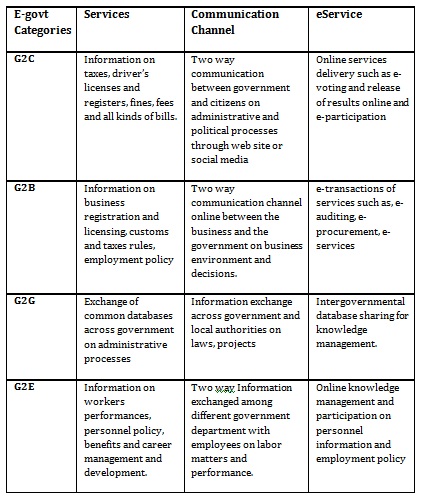
Enterprise Architecture
The concept of Enterprise Architecture (EA) is believed to have been originated from the pioneering work of John Zachman who is frequently referred to as the “Father” of Enterprise Architecture (Information and Council, 2010). This statement is further supported by Urbaczewski and Mrdalj (2006) that Enterprise architecture creates an organizations’ roadmap for it to achieve its business strategy and mission using information technology. Enterprise Architecture can be defined as a model of an organization that depicts its current and future structure and processes aligned with its core goals and strategic direction using information technology (Zachman, 2003). The main objective of enterprise architecture is full optimization of the business organization by being customer centered (Information and Council, 2010). Lack of well-defined Enterprise Architecture for the Government can be a huge hindrance in the successful implementation of e-government (Ebrahim and Irani, 2005). Ebrahim and Iran (2005) proposed a four staged enterprise framework namely; Infrastructure Layer, E-business Layer, E-government Layer and Access Layer. The adoption of enterprise architecture for e-government aligns all Information Technology assets with business strategy of an organization (Chief and Officers, 1999; Urbaczewski and Mrdalj, 2006).
The E-government Development Index
The e-government development index (EGDI) is based on an expert survey used by the United Nations to measure the adoption of ICT in government for the delivery of essential public services (United Nations, 2002). Mathematically, the EGDI is a weighted average of normalized scores on the three most important elements of e-government, namely: Telecommunication Infrastructure, Online Services, Human Capital and E-participation as sub indicator (UNDESA, 2016). Based on the EGDI survey, policy makers can evaluate the performance and adoption of the telecommunication in their country according to the three elements.
E-government is not only having a government website on the internet, it is having processes that are citizens focused (Basu, 2004). According to Gartner (2000), government should be able to provide services using the websites and the websites should be able to efficiently provide the features that make it convenient for citizens to access services.
Zambia’s E-government Ranking
Zambia is ranked 132 in the world according to the e-government development index report of 2016. Table 2. In a space of two years (2014 to 2016), Zambia has improved its ranking by moving 31 places upwards (UNDESA, 2016). This could be due to private sector collaboration in the development of the sector (R.ICTSolutions, 2017). However, despite, the upward improvements, Zambia is not among the top ten performing countries in Africa. All African countries are in the lower two tiers of the e-government development index (the low-EGDI and middle-EGDI categories). The top performers of e-government with high EGDI values are Mauritius, ranked globally at 58th, Tunisia at 72nd, South Africa at 76th, Morocco at 85th, and Seychelles at 86th.
Table 2: Zambia’s EGDI
Online Services Index
The Online Service Index (OSI) of the e-government development index, measures the use of ICT by government to distribute basic public services to citizens using the internet (UNDESA, 2016). The survey assesses the technical features of government websites as well as policies and strategies that support the delivery of e-services. The online service index (OSI) is also driven from the e-government website development stages of Gartner (2000) and Layne & Lee (2001). Government online services are rated based on features that allow citizens to transact, search, and download. However, according to the EGDI (2016), Zambia’s online index is slightly above the regional average at 0.3693. The regional leader is Morocco at 0.7391 followed by Mauritius at 0.729. The world leader is United Kingdom of the Great Britain and Northern Ireland both sharing 1.0000 index.
Telecommunication Infrastructure
The Telecommunication Infrastructure Index (TII) is used to measure five key indicators which include; Internet Users per 100 inhabitants, Number of fixed telephone lines per 100 inhabitants, Number of mobile subscribers per 100 inhabitants, Number of fixed broadband facilities per 100 inhabitants and Number of wireless broadband subscriptions per 100 inhabitants (UNDESA, 2016). The TII assesses the connectivity of Infrastructure to distribute e-service between G2C, G2B, G2G and G2E. Zambia’s Telecommunication Index (TII) at 0.1182.
However, according to the ICT Development Index report of 2017, Zambia is ranked number 146 in the world ICT development Index (ITU, 2017). Mobile phone subscription per 100 inhabitants is at 74.95% against the regional average of 96.2%. Internet subscription is 25.51%, fixed wired broadband subscription 0.2%, fixed telephone subscription 0.63% and households with computers 8%. Zambia has made progress towards the development of the telecommunication infrastructure, but more still needs to be done to close the digital divide especially in rural areas. Distribution of e-service and infrastructure development should not be concentrated along line of rail but should be taken across the country regardless of geographical location (Odat and Khazaaleh, 2012). If these issues are not adequately addressed, they may affect the development and distribution of public services mainly to people living in remote areas.
Human Capital Index
Human capital index is one of the critical indicators to measure the adoption of e-government. It is a weighted average composite of the four indicators namely: adult literacy rate; combined primary, secondary and tertiary enrollment ratio. Zambia’s human capital index in Zambia is at 0.5643 slightly above the regional averaged Index of 0.4318. Table 3.
Table 3: Zambia’s Human Capital Development Index
Methodology
Research Strategy and Approach
The study adopted both qualitative and quantitative (positivism and interpretive) approach. This approach was recommended because mixed approach provides both numerical and descriptive details to the study and it minimizes research biasness. The research targeted 25 government ministries and 6 local authorities mainly along the line of rail. Survey questionnaires were used and manually and electronically distributed. 85 participants successfully responded. Those who participated were Managers of ICT and officers at operational level. These were purposively selected and users of government services were randomly selected and interviewed. This was coupled with follow up meetings to gain acceptance of participants for the research. The researcher also held meetings with the Commissioner Secretary at the Local Government Service Commission to gain authority to distribute questionnaires to local authorities.
In order to gain more understanding and gather adequate information about the study, the researcher also used secondary data from past researchers on e-government development in developing countries. Literature from previous studies was comprehensively reviewed more specifically the United Nations E-government Development Survey of 2016. Websites were reviewed and guided by Gartner (2000) e-government web development stages. Government websites were reviewed based on web presence, interaction, transaction and transformation.
The data collected was analyzed using Microsoft Excel. The data was further arranged in five categories namely; telecommunication infrastructure, human capital, online service, change management, and integration system.
Findings
Telecommunication Infrastructure
Figure 1, shows the status of Telecommunication Infrastructure in government ministries and local authorities in Zambia. The research shows that 14% of the Telecommunication Infrastructures is adequate to support the distribution and access of electronic services while 86% is inadequate.
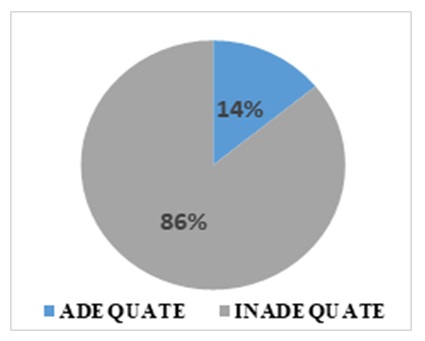
Figure 1: ICT Infrastructure
Web Presence
Figure 2, shows that 88% of government Ministries and Local Authorities have some form of web presence which they can use to communicate with their customers or citizens while only 14% do not have web presence. This is a good indicator that government is taking necessary steps to adopt ICT and have online presence to communicate with people using the internet.
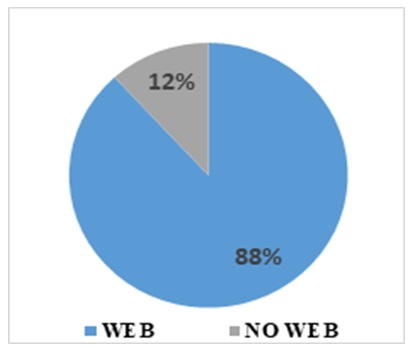
Figure 2: Web Presence
Human Capital
Figure 3, shows that 19% of the local skills are available to drive the implementation of e-government while 81% lack specialized skills.

Figure 3: Human Capital
Change Management
According to the findings depicted in Figure 4, 16% of Change Management activities have been conducted in line with creating awareness, sensitization about e-government implementation in government Ministries and Local Authorities. However, 84% of the finding suggested that there is inadequate awareness and sensitization to the people about the e-government and its benefits to government.
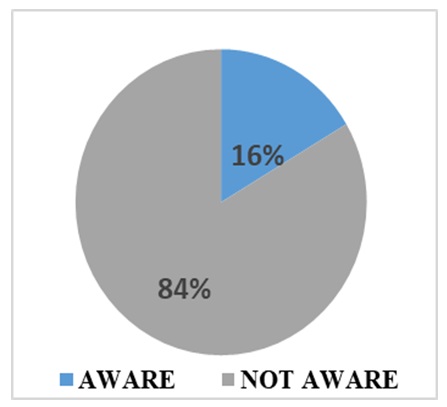
Figure 4: Change Management
Business Systems Integration
Despite having good percentage on web presence as highlighted in Figure 2, the findings from figure 5, showed that 81% of online systems are partially integrated or they do not share common databases. The websites only offer content but they do offer advanced features such as transactional services, submission of forms and other features while 19% are fully integrated. Fully integrated systems means when one submits details once; there should be no need to resubmit the same information elsewhere with government. The information should sync and be queried using application programming interfaces making an enterprise government system. This is not the case with these findings.
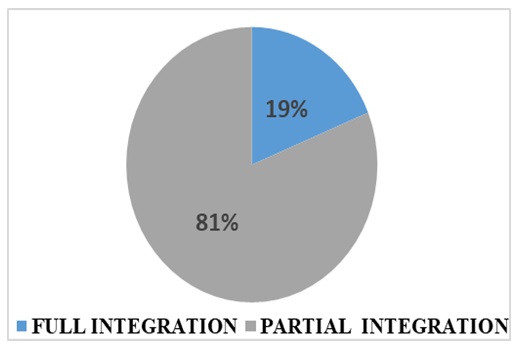
Figure 5: Government Systems Integration
Implementing Road Map
The research revealed, as shown in Figure 6, that 80% suggest that there is no existing implementation framework to guide the deployment of e-government agenda while 20% suggest there is an implementation framework guiding e-government.

Figure 6: E-gov Implementation Strategy
Summary of Findings
Figure 7, depicts the summary of all the findings related to the six indicators used as above in the finding. However, from the six indicators as in above, the researcher calculated the average percentage as represented in Figure 7. However, it was established that they are 29% opportunities and 71% challenges to successfully implement and support e-services.
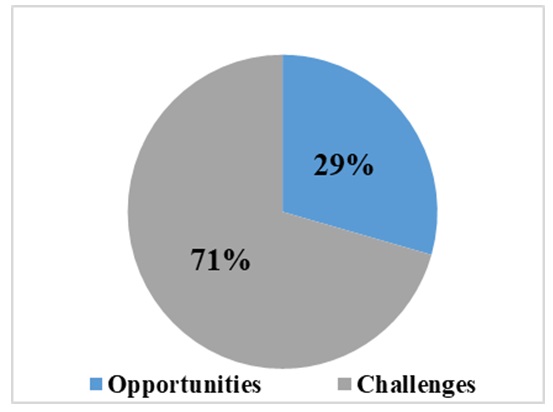
Figure 7: Summary
Conclusion
This paper has brought out basic fundamental concepts and theories of e-Government especially on how they contribute to successful implementation of e-Government implementation in developing countries more specifically in Zambia. According to Zechariah and Iran (2004), successful implementation of e-government requires an enterprise business approach where ICT assets are aligned with the core business model of an organization. Successful e-government implementation enhances the interaction between government and citizens who are the key government customers. E-government promotes open government data and makes government information easily accessible for public consumption. This is a critical value for good governance. This is according to the objective of e-government which is being citizen centered.
Recommendation
The significance of ICT can never be over emphasized more especially in a growing economies like Africa. Key sectors such as governance, health, tourism and education entirely depend on ICT to effectively function. African governments need to reinforce policies on Universality. There is need to encourage more adoption and use of ICT services in public institutions to effectively deliver services to the people. Zambia still has very few automated government services which can be accessed by people online.
The development of the telecommunication infrastructure in Africa and particularly in Zambia is more concentrated in densely populated areas for commercial purposes. Rural areas are lowly developed. Policies on universal access and services need to be prioritized and reinforced. The penetration of first level smart phone and use of internet services at household level is still very low in rural areas. Governments should ensure the availability, accessibility and affordability of ICT services for all. The universal access fund collected by regulators should be used to take infrastructure development in rural areas and train people basic ICT skills in order to bridge digital divide.
Reference
- Basu, S. (2004) ‘E‐government and developing countries: an overview’, International Review of Law, Computers & Technology, 18(1), pp. 109–132. doi: 10.1080/13600860410001674779.
- Bhatnagar, S. (2004) E-GOVERNMENT From Vision to Implementation. SAGE.
- Bhatnagar, S. C. (2002) ‘E-government: Lessons from implementation in developing countries’, Regional Development Dialogue, 23(2), pp. 164–173.
- Chief, T. and Officers, I. (1999) ‘Federal Enterprise Architecture Framework’, (September).
- Ebrahim, Z. and Irani, Z. (2005) ‘E-government adoption: architecture and barriers’, Business Process Management Journal, 11(5), pp. 589–611. doi: 10.1108/14637150510619902.
- Fang, Z. (2002) ‘E-government in digital era: concept, practice, and development’, International journal of the Computer, the Internet and …, 10(2), pp. 1–22. Available at: http://sahra.org.za/sites/default/files/additionaldocs/10.1.1.133.9080.pdf.
- Fang, Z. and Ph, D. (2002) ‘E-Government in Digital Era : Concept , Practice , and Development’, 10(2), pp. 1–22.
- Faokunla, O. A. (2012) ‘Government-to-Government E-Government: A Case Study of a Federal Financial Program’, ProQuest Dissertations and Theses, p. 317. Available at: http://search.proquest.com/docview/925625245?accountid=41453.
- Habeenzu, S. (2010) ‘Zambia ICT Sector Performance Review’.
- Heeks, R. (2003) ‘Most eGovernment-for-Development Projects Fail: How Can Risks be Reduced?’, iGovernment Working Paper Series, (14), pp. 1–30. doi: 10.1017/CBO9781107415324.004.
- Heeks, R. and Bhatnagar, S. (1999) ‘Published in Reinventing Government in the Information Age, Heeks, Richard (Ed), Routledge, London, 1999, pp 49-74.’, Reinventing Government in the Information Age, pp. 49–74.
- Hughes, O. E. (2003) Public Management and Administration: an introduction.
- Information, C. and Council, O. (2010) ‘A Practical Guide to Federal Enterprise Architecture’, (August).
- ITU (2009) ‘Framework for e-Gov toolkit’, pp. 1–35.
- ITU (2017) Measuring the Information Society Report 2017 – Volume 1, International Telecommunication Union. doi: 10.3359/oz0303157.
- Joseph, B. K. (2017) ‘Determining Factors Influencing E-Government Development in the Developing World : A Case Study of Zambia’, 2017. doi: 10.5171/2017.143795.
- Kovačić, Z. J. (2005) ‘The impact of national culture on worldwide eGovernment readiness’, Informing Science, 8, pp. 143–158.
- Layne & Lee (2001) ‘Developing fully functional E- government: A four stage model’, Government Information Quarterly, 18(2), pp. 122–136.
- Lootah, R. and Geray, O. (2006) ‘Dubai eGovernment Case Study’, (March).
- MCT, Z. (2006) ‘National information and communication technology policy’.
- Mulikita, N. M. (1996) ‘Zambia ’ s Developmental Concerns beyond 1996 . Seminar Report of Zambia’s PSRP National Workshop.’, Seminar Report of Zambia’s PSRP National Workshop. The Zambian Civil Service Reform (PSRP) Facing An Uncertain Future .
- Ndou, V. D. (2004) ‘E – Government for Developing Countries: Opportunities and Challenges’, EJISDC The Electronic Journal on Information Systems in Developing Countries, 18(1), pp. 1–24. doi: .
- Odat, A. and Khazaaleh, M. (2012) ‘E-Government Challenges and Opportunities : A Case Study of Jordan’, 9(5), pp. 361–367.
- OECD (2015) OECD Digital Economy Outlook 2015. doi: http://dx.doi.org/10.1787/9789264232440-en.
- ICTSolutions (2017) ‘Zambia ICT Gap Analysis’, (2017), pp. 1–15.
- Saxena, K. B. C. (2005) ‘Towards excellence in e‐governance’, International Journal of Public Sector Management, 18(6), pp. 498–513. doi: 10.1108/09513550510616733.
- Schuppan, T. (2009) ‘E-Government in developing countries: Experiences from sub-Saharan Africa’, Government Information Quarterly. Elsevier Inc., 26(1), pp. 118–127. doi: 10.1016/j.giq.2008.01.006.
- Seifert, J. W. (2003) ‘A Primer on E-Government : Sectors, Stages, Opportunities, and Challenges of Online Governance’, Report for Congress, p. 24. doi: RL31057.
- Seifert, J. W. and Chung, J. (2008) ‘Using E-Government to Reinforce Government–Citizen Relationships: Comparing Government Reform in the United States and China’, Social Science Computer Review, 27(1), pp. 3–23. doi: 10.1177/0894439308316404.
- UNDESA (2016) UN E-government survey 2016. E-Government in Support of Sustainable Development. doi: 10.1016/S1369-7021(02)00629-6.
- United Nations, U. (2002) ‘Benchmarking E-government : A Global Perspective’.
- Urbaczewski, L. and Mrdalj, S. (2006) ‘A comparison of enterprise architecture frameworks’, Issues in Information Systems, 7(2), pp. 18–23. doi: 10.1227/01.neu.0000410082.42657.aa.
- Zachman, J. a (2003) ‘The Zachman Framework For Enterprise Architecture, Primer for Enterprise Engineering and Manufacturing’, CA Magazine, 128(9), p. 15. doi: 10.1109/CSIE.2009.478.












